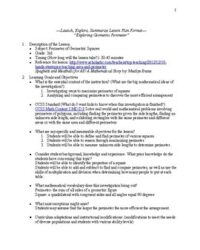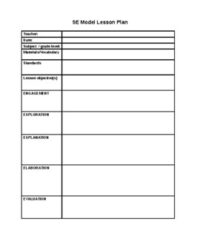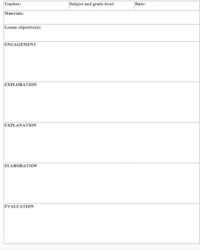In the dynamic world of education, crafting lesson plans that truly resonate with students and foster deep understanding can feel like an art form. It is about more than just delivering content; it is about facilitating a journey of discovery and retention. That is where the 7 E learning model shines, providing a robust framework that guides educators in creating engaging and effective learning experiences.
This approach moves beyond simple instruction, encouraging students to actively participate in their learning process. By following a structured path through distinct phases, teachers can ensure comprehensive coverage of concepts, from sparking initial curiosity to evaluating mastery and encouraging future application. The right template can transform this complex process into a streamlined, intuitive task, ensuring every crucial step is addressed.
Understanding the Power of the 7 E Model
The 7 E learning model is an expanded version of the popular 5 E instructional model, a constructivist approach developed by Biological Sciences Curriculum Study (BSCS). It is designed to engage students in active learning, allowing them to construct their own understanding of concepts rather than passively receiving information. The core idea is that learning is a process of building new ideas upon existing ones, and the 7 E’s provide a logical progression for this construction.
The original 5 E’s – Engage, Explore, Explain, Elaborate, and Evaluate – laid a strong foundation for inquiry-based learning. They encouraged teachers to move students through phases of initial curiosity, hands-on investigation, concept clarification, application of knowledge, and assessment of understanding. This model significantly improved student engagement and retention by making learning more interactive and student-centered.
However, educators soon recognized that while effective, there were opportunities to enhance the model further, particularly in preparing students for learning and helping them solidify knowledge over time. The addition of two more E’s – Elicit and Extend – transformed the framework into the more comprehensive 7 E model. This expansion addresses the need to tap into prior knowledge more explicitly at the outset and to provide avenues for students to apply their new understanding beyond the immediate lesson, making the learning even more robust and long-lasting.
By breaking down the learning journey into these seven distinct yet interconnected phases, teachers gain a clear roadmap for designing lessons that are not only comprehensive but also highly effective in promoting deep learning. Each ‘E’ serves a specific purpose, building upon the previous one to guide students through a complete learning cycle. Understanding each component is key to maximizing the potential of a 7 e lesson plan template.
Elicit: Sparking Prior Knowledge
This is the first step, designed to uncover what students already know or think they know about a topic. It helps teachers identify misconceptions and activate relevant background information. Activities here might include brainstorming, quick writes, or KWL charts.
Engage: Hooking Their Interest
The Engage phase aims to capture students’ attention and pique their curiosity. It creates a mental connection to the new topic through a short, attention-grabbing activity, question, or scenario. This sets the stage for the learning that is about to unfold.
Explore: Hands-On Discovery
In this phase, students actively investigate the concept through direct experience, experiments, or collaborative activities. They gather information, observe phenomena, and formulate questions, often working in groups to facilitate discovery.
Explain: Clarifying Concepts
After exploration, students and teachers work together to formalize the understanding. This is where new terms are introduced, concepts are defined, and explanations are provided based on the students’ explorations. The teacher acts as a guide, helping students articulate what they have discovered.
Elaborate: Deepening Understanding
This phase is about applying the newly learned concepts to new situations or solving problems. Students extend their understanding by making connections, applying knowledge to real-world scenarios, and engaging in more complex tasks that reinforce their learning.
Evaluate: Assessing Learning
Throughout the learning cycle, but particularly at this stage, both teachers and students assess understanding. This can involve formal assessments, informal observations, self-reflection, or peer review. The goal is to determine if learning objectives have been met and identify areas for further support.
Extend: Applying New Knowledge
The final phase encourages students to apply their new understanding in different contexts, often connecting it to other disciplines or real-world issues. It is about fostering a sense of lifelong learning and showing how the knowledge can be used beyond the classroom setting, encouraging deeper, more meaningful retention.
Why a Dedicated 7 E Lesson Plan Template Makes All the Difference
Designing lessons that effectively incorporate all seven Es can initially seem daunting. Each phase requires careful thought, specific activities, and clear learning outcomes. Without a structured approach, it is easy to overlook a crucial step or disproportionately focus on one area while neglecting others. This is where a well-designed 7 e lesson plan template becomes an indispensable tool for educators, transforming a complex instructional model into an actionable plan.
A comprehensive template acts as a checklist and a guiding framework, ensuring that every aspect of the 7 E model is considered and integrated into your lesson. It promotes consistency in your teaching approach, guaranteeing that students consistently experience the full benefits of this constructivist method. Moreover, a template saves valuable planning time, allowing you to focus on the creative aspects of lesson design rather than worrying about structural elements. It also serves as a fantastic resource for reflecting on your lessons and identifying areas for improvement in future iterations.
By using a specific 7 e lesson plan template, teachers can confidently craft lessons that are not only engaging and rigorous but also systematically address student learning at every stage. It ensures that you are consistently activating prior knowledge, fostering curiosity, providing opportunities for hands-on exploration, facilitating clear explanations, encouraging deep application, assessing understanding effectively, and promoting the extension of learning into new contexts. This systematic approach leads to more thorough and impactful teaching.
- Clearly define your learning objectives before you begin filling out the template. This ensures that every E phase is aligned with your desired outcomes.
- Tailor each section of the template to your specific subject matter and the unique needs of your students. A template is a guide, not a rigid rulebook.
- Don’t be afraid to add notes or adaptations directly within your template as you plan or after teaching the lesson. This helps refine your approach over time.
- Review your completed plan to ensure a logical flow and comprehensive coverage of the 7 E’s, imagining yourself as a student going through the lesson.
- Consider how you will differentiate instruction within each phase to meet the diverse learning needs of all students in your classroom.
Embracing the 7 E learning model, especially with the aid of a structured template, empowers educators to design lessons that are truly transformative. It fosters an environment where students are not just recipients of information but active constructors of their own knowledge, leading to deeper understanding and more meaningful learning experiences. This systematic approach ensures that every lesson is a well-rounded journey, from initial curiosity to lasting application.
Ultimately, by consistently applying this powerful framework, teachers can cultivate a classroom where inquiry thrives, engagement is high, and students are prepared not just for assessments, but for a lifetime of learning and critical thinking. It is about creating an educational experience that builds confidence and competence, one thoughtfully designed lesson at a time.


